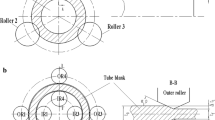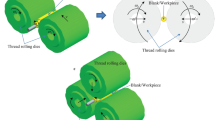Abstract
The internal thread is the most important part of the components. Any processing failure or reduction in precision cannot achieve the perfect assembly of the components without gaps. As a vital parameter to evaluate the quality of internal threads, radial pitch diameter difference has a great influence on the processing quality of internal threads. When matched with qualified external threads, radial pitch diameter difference exceeds the allowable value of the internal thread, the life and reliability of the threaded connection will be reduced, and the threaded connection may fail completely and even cause huge economic losses. Unfortunately, there are few reports on the research of radial pitch diameter difference in the past. In actual production, due to the harsh conditions of the tapping process, it is difficult to accurately control radial pitch diameter difference of threads, which results in that the quality of small-diameter internal threads cannot be guaranteed. Therefore, this paper developed a quasi-static model to predict radial pitch diameter difference in tapping and simulates radial pitch diameter difference at different chamfer lengths and spindle speeds through this model. The simulation results show that the chamfer length and spindle speed have an effect on radial pitch diameter difference. It is the smallest at 2 pitches and 1400 rev/min, which are 1.4 mm and 1.8 mm, respectively. In a word, tapping simulation not only determines the influencing factors of radial pitch diameter difference, but also reduces test costs, laying a solid foundation for the further experimental research.









Similar content being viewed by others
Data Availability
The data sets supporting the results of this article are included within the article and its additional files.
References
Fetullazade E, Akyildiz HK, Saritas S (2010) Effects of the machining conditions on the strain hardening and the residual stresses at the roots of screw threads. Mater Des 31:2025–2031
Dong Y, Hess DP (1999) The effect of thread dimensional conformance on vibration-induced loosening. J Vib Acoust 121:209–213
Korin I, Ipina JP (2011) Experimental evaluation of fatigue life and fatigue crack growth in a tension bolt-nut threaded connection. Int J Fatigue 33:166–175
Pesin MV (2012) Improving the reliability of threaded pipe joints. Russ Eng Res 32:210–212
Gadelmawla ES (2004) A novel system for automatic measurement and inspection of parallel screw threads. Proc Inst Mech Eng Part B J Eng Manuf 218:545–556
Araujo AC, Mello GM, Cardoso FG (2015) Thread milling as a manufacturing process for API threaded connection: Geometrical and cutting force analysis. J Manuf Process 18:75–83
Zhu X, Zhang Z (2017) Design of an ultra-high torque double shoulder drill-pipe tool joint for extended reach wells. Nat Gas Ind B 4:374–381
Carvalho AOD, Brandão LC, Panzera TH, Lauro CH (2012) Analysis of form threads using fluteless taps in cast magnesium alloy (AM60). J Mater Process Technol 212:1753–1760
Pereira IC, Da Silva MB, Da Cunha DF, Sales WF (2016) Analysis of tapping process in three types of cast iron. Int J Adv Manuf Technol 82:1041–1048
Malkov OV, Malkova LD (2019) Improving thread accuracy in machining components for rocket and space technologies. AIP Conf Proc 2171:200006
Khoshdarregi M, Altintas Y (2018) Dynamics of multipoint thread turning-part I: General formulation. J Manuf Sci Eng 140:061003
Araujo AC, Fromentin G (2018) Investigation of tool deflection during milling of thread in Cr-Co dental implant. Int J Adv Manuf Technol 99:531–541
Malkov OV, Karelsky AC (2019) Rising the work uniformity of thread milling cutters in machining parts of rocket and space technology. AIP Conf Proc 2171:200005
Wan M, Altintas Y (2014) Mechanics and dynamics of thread milling process. Int J Mach Tools Manuf 87:16–26
Khoshdarregi MR, Altintas Y (2015) Generalized modeling of chip geometry and cutting forces in multi-point thread turning. Int J Mach Tools Manuf 98:21–32
Wan M, Ma YC, Feng J, Zhang WH (2017) Mechanics of tapping process with emphasis on measurement of feed error and estimation of its induced indentation forces. Int J Mach Tools Manuf 114:8–20
Min J (2015) Comprehensive measurement system for screw thread parameter based on machine vision. In: 2015 International Conference on Computer and Computational Sciences (ICCCS) pp. 266-270
Fromentin G, Poulachon G, Moisan A, Julien B, Giessler J (2005) Precision and surface integrity of threads obtained by form tapping. CIRP Ann - Manuf Technol 54:519–522
Piska M, Sliwkova P (2015) A study of cutting and forming threads with coated HSS taps. J Mach Eng 15:65–74
Hsu CC, Yeh SS, Lee JI (2016) Effect analysis and optimal combination of cutting conditions on the cutting torque of tapping processes using Taguchi methods. In: 2016 IEEE International Conference on Automation Science and Engineering (CASE) pp. 1215-1218
Bratan S, Novikov P, Roshchupkin S (2016) Application of Combined Taps for Increasing the Shaping Accuracy of the Internal Threads in Aluminium Alloys. Procedia Eng 150:802–808
Leon FM, Pai NG, Hess DP (2001) The effect of thread dimensional conformance on yield and tensile strength. Eng Fail Anal 8:49–56
Nassar SA, Munn BS, Yang X (2009) Effect of Non-Conforming Thread Root Radius on the Fatigue Performance of Preloaded Threaded Fasteners. In: ASME 2008 Pressure Vessels and Piping Conference pp. 803-809
Ahmadi K, Altintas Y (2013) Stability of lateral, torsional and axial vibrations in drilling. Int J Mach Tools Manuf 68:63–74
Ma YC, Wan M, Yang Y, Zhang WH (2019) Dynamics of tapping process. Int J Mach Tools Manuf 140:34–47
Bayly PV, Young KA, Calvert SG, Halley JE (2001) Analysis of tool oscillation and hole roundness error in a quasi-static model of reaming. J Manuf Sci Eng 123:387–396
Deng CS, Chin JH (2004) Roundness errors in BTA drilling and a model of waviness and lobing caused by resonant forced vibrations of its long drill shaft. J Manuf Sci Eng 126:524–534
Cao T, Sutherland JW (2002) Investigation of thread tapping load characteristics through mechanistics modeling and experimentation. Int J Mach Tools Manuf 42:1527–1538
Towfighian S, Behdinan K, Papini M, Saghir Z, Zalzal P, De Beer J (2007) Finite element modeling of low speed reaming vibrations with reamer geometry modifications. J Intell Manuf 18:647–661
Whitehead BT, Bayly PV, Calvert SG (2001) The effect of process damping on stability and hole form in drilling. In: SAE Aerospace Manufacturing Technology Conference 2001 Aerospace Congress pp. 2605
Chen NM, Smith AJR (2011) Modelling of straight-flute machine tapping. Proc Inst Mech Eng Part B J Eng Manuf 225:1552–1567
Kaymakci M, Kilic ZM, Altintas Y (2012) Unified cutting force model for turning, boring, drilling and milling operations. Int J Mach Tools Manuf 54:34–45
Ahmadi K, Savilov A (2015) Modeling the mechanics and dynamics of arbitrary edge drills. Int J Mach Tools Manuf 89:208–220
Jiménez A, Arizmendi M, Cumbicus WE (2018) Model for the prediction of low-frequency lateral vibrations in drilling process with pilot hole. Int J Adv Manuf Technol 96:1971–1990
Wang C, Guan W, Wang JY, Zhong B, Lai X, Chen Y, Xiang L (2018) Adaptive operational modal identification for slow linear time-varying structures based on frozen-in coefficient method and limited memory recursive principal component analysis. Mech Syst Signal Process 100:899–925
Insperger T, Stépán G (2011) Semi-Discretization for Time-Delay Systems. Springer, New York, New York
Eynian M, Altintas Y (2010) Analytical Chatter Stability of Milling With Rotating Cutter Dynamics at Process Damping Speeds. J Manuf Sci Eng 132:021012
Funding
The research is financially supported by the National Natural Science Foundation of China (No. 51275333)
Author information
Authors and Affiliations
Contributions
Jie Ren developed a model to predict the radial diameter difference of threads, analyzed the simulation results, and was a major contributor in writing the manuscript. Xianguo Yan provided guidance for the writing of manuscript. All the authors read and approved the final manuscript.
Corresponding author
Ethics declarations
Ethical approval
All analyses in this paper are based on previously published research, and this paper does not involve animal and human testing, so this item is not applicable to this paper.
Consent to participate
All analyses in this paper are based on previously published research, and this paper does not involve animal and human testing, so this item is not applicable to this paper.
Consent for publication
The author confirms: that the work described has not been published before (except in the form of an abstract or as part of a published lecture, review or thesis); that it is not under consideration for publication elsewhere; that its publication has been approved by all co-author, if any; and that its publication has been approved (tacitly or explicitly) by the responsible authorities at the institution where the work is carried out. The author agrees to publication in the journal indicated below and also to publication of the article in English by Springer in Springer’s corresponding English-language journal. The copyright of the English article is transferred to Springer effective if and when the article is accepted for publication.
Additional information
Publisher’s Note
Springer Nature remains neutral with regard to jurisdictional claims in published maps and institutional affiliations.
Rights and permissions
About this article
Cite this article
Ren, J., Yan, X. Tapping simulation to reduce radial pitch diameter difference of threads. Int J Adv Manuf Technol 119, 3091–3103 (2022). https://doi.org/10.1007/s00170-021-08458-5
Received:
Accepted:
Published:
Issue Date:
DOI: https://doi.org/10.1007/s00170-021-08458-5




